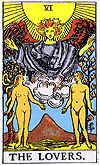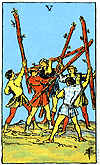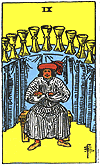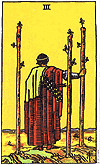Card Combinatorics
Learning the basic meanings of the cards by themselves is fairly simple,
whether it is done through symbolism, correspondences, or even memorization.
But these techniques are not nearly as useful when the student moves on to
the far more important task of relating cards to each other in a spread.
Other methods are needed to fit together the various card meanings into a
cohesive and sensible whole. One of these other methods, which I outline
below, is the use of keywords to tie cards together. I find that keywords
can be useful for interpretation of cards by themselves, but it is when two
cards must combine that keywords become extremely beneficial.
The process is so simple that most people don't even consider it when they
try to combine cards. To find the meaning of two cards combined, combine
their keywords in various ways and see what results. That's the method in
a single sentence, and the remainder of this section serves merely to show
examples of this process, and the various ways that it can be used to link
together all kinds of different cards.

 For our first example, let's consider a spread in which the Lovers and the
Five of Wands were drawn. Two possible keywords for the Five (of the many
dozen that one could use) are "challenge" and "competition". Similarly,
the Lovers can be represented by "love" and "choice" for the purposes of
this example. Simple arithmetic gives us four possible combinations, and
we can come up with a short phrase to describe each one.
For our first example, let's consider a spread in which the Lovers and the
Five of Wands were drawn. Two possible keywords for the Five (of the many
dozen that one could use) are "challenge" and "competition". Similarly,
the Lovers can be represented by "love" and "choice" for the purposes of
this example. Simple arithmetic gives us four possible combinations, and
we can come up with a short phrase to describe each one.
Challenge + Love
- A relationship plagued by challenges
- Obstacles standing in the way of romance
Competition + Love
- Two people fighting over a common love interest, or
- One person trying to decide between two suitors
Challenge + Choice
- A difficult choice that must be made about something
Competition + Choice
- Whether or not one should compete
- To fight or to flee
An interesting consequence about these phrases is that options 1 and 4 fit
together nicely. When a long-lasting relationship falls on hard times (1)
do you hold fast or give up (4)? In a similar manner, 2 and 3 harmonize.
Either way you look at the situation in (2), one of the participants will
have to make the tough choice described in (3). So you really have only
two interpretations for the combination, and which one you pick depends on
the rest of the cards in the spread and the question that was asked of you.
(One could actually see all four of these combinations as different sides
of the same issue but that might be taking it to the extreme.)

 Sometimes one or more of the combinations you end up with, after placing
various keywords together, might not make much sense. For example, say I
combine the Nine of Cups ("satisfaction" and "pleasure") with the Three of
Swords ("heartbreak" and "pain"). We have, once again, four options:
Sometimes one or more of the combinations you end up with, after placing
various keywords together, might not make much sense. For example, say I
combine the Nine of Cups ("satisfaction" and "pleasure") with the Three of
Swords ("heartbreak" and "pain"). We have, once again, four options:
- Satisfaction + Heartbreak
- Pleasure + Heartbreak
- Satisfaction + Pain
- Pleasure + Pain
None of them make much sense, do they? The concepts of satisfaction and
of pain, for example, do not relate well to each other in the vast majority
of circumstances. When this happens, we can combine them with prepositions
and other connective words. In this case, let's assume that the Nine was
in the Past position and that the Three was in the Present position. Then
we have one of these two cases:
1) a simple before-after relationship
Satisfaction before Heartbreak, Pleasure followed by Pain, etc.
2) a causal relationship
Pleasure causes Heartbreak, Satisfaction brings Pain, etc.
Both of these cases make the situation much clearer. If these cards came up
in a reading for a female client who was feeling unhappy and depressed, it
would mean one of two things. Either someone did something to the client
to make her stop feeling happy and start feeling sad (perhaps a breakup or
an argument), or the client herself turned something very pleasurable into
something painful (by, perhaps, going out with another guy and causing her
current boyfriend to leave her).

 I keep using the example of a relationship because that's what most clients
ask about and that's what Cups cards often refer to. But just for variety,
let's look at an example that has nothing at all to do with relationships,
and combine the Three of Wands ("leadership" and innovation") with the Four
of Pentacles ("stability" and "stagnation")
I keep using the example of a relationship because that's what most clients
ask about and that's what Cups cards often refer to. But just for variety,
let's look at an example that has nothing at all to do with relationships,
and combine the Three of Wands ("leadership" and innovation") with the Four
of Pentacles ("stability" and "stagnation")
Leadership + Stability
- A strong hand holds a volatile situation together
Innovation + Stability
- A new way of doing things reduces stress or tension
Leadership (brings) Stagnation
- People are so used to following the orders of others
that they can no longer act on their own
Innovation (followed by) Stagnation
- Thinking of new ways was difficult so a person or a
company just kept doing things the old way
These four cases are somewhat different and cannot be harmonized as neatly
as those for the Five of Wands/Lovers combination. Still, based on the
particular situation and the surrounding cards, it should be possible to
spot which of the four cases is the correct choice. Further interpretation
can then be done with the combination as a basis.
What I've presented here is a general method for combining cards together.
In some cases you can extend it to three or more cards by simpling adding
more keywords to the equation. At other times it will be more helpful if
you combine two cards and the use a third to clarify or choose between two
possibilities. So if you draw a Five of Wands, The Lovers and a Five of
Pentacles, it's likely that the "difficult choice" described by the first
two cards is something related to work or finances, and not to romance.
Of course, nothing is stopping you from linking the other pairs of cards
together and seeing what you get from those.
At first, this method is very slow because you have to consider different
combinations in depth before one becomes apparent as the correct answer.
With time and practice you can almost instantly see which keywords have
united to describe the particular situation, and when this time comes, the
process of card combinatorics is no longer a mechanical procedure, but an
intuitive understanding of the patterns found in a reading.
Copyright 2000 James Rioux

 For our first example, let's consider a spread in which the Lovers and the
Five of Wands were drawn. Two possible keywords for the Five (of the many
dozen that one could use) are "challenge" and "competition". Similarly,
the Lovers can be represented by "love" and "choice" for the purposes of
this example. Simple arithmetic gives us four possible combinations, and
we can come up with a short phrase to describe each one.
For our first example, let's consider a spread in which the Lovers and the
Five of Wands were drawn. Two possible keywords for the Five (of the many
dozen that one could use) are "challenge" and "competition". Similarly,
the Lovers can be represented by "love" and "choice" for the purposes of
this example. Simple arithmetic gives us four possible combinations, and
we can come up with a short phrase to describe each one.
 Sometimes one or more of the combinations you end up with, after placing
various keywords together, might not make much sense. For example, say I
combine the Nine of Cups ("satisfaction" and "pleasure") with the Three of
Swords ("heartbreak" and "pain"). We have, once again, four options:
Sometimes one or more of the combinations you end up with, after placing
various keywords together, might not make much sense. For example, say I
combine the Nine of Cups ("satisfaction" and "pleasure") with the Three of
Swords ("heartbreak" and "pain"). We have, once again, four options:

 I keep using the example of a relationship because that's what most clients
ask about and that's what Cups cards often refer to. But just for variety,
let's look at an example that has nothing at all to do with relationships,
and combine the Three of Wands ("leadership" and innovation") with the Four
of Pentacles ("stability" and "stagnation")
I keep using the example of a relationship because that's what most clients
ask about and that's what Cups cards often refer to. But just for variety,
let's look at an example that has nothing at all to do with relationships,
and combine the Three of Wands ("leadership" and innovation") with the Four
of Pentacles ("stability" and "stagnation")